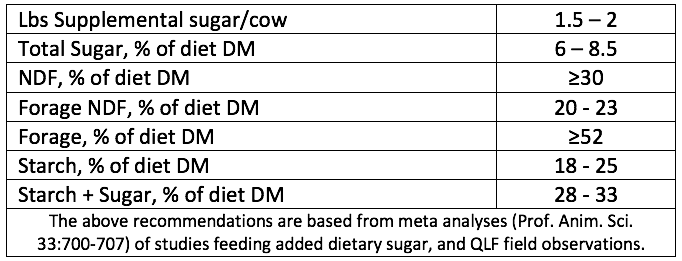by Lisa Davis, Dairy Product Manager
Maximizing returns from the feeding program is essential to both long and short-term profitability. Here are 5 easy ways to make the most $$ from feeding QLF!
- Choose the cows. Cows early in lactation are naturally more productive and efficient at turning feed into milk. Late lactation cows partition additional resources toward body condition and calf growth, which is essential to their productive life but reduces efficiency and quantity of milk and component production. Meta-analysis has indicated that higher producing cows (>33 kg/day) showed the best production responses to feeding 5 – 7% supplemental sugar (Prof. Anim. Sci. 33:700-707). In addition, the meta-analysis also indicated that optimal responses to supplemental sugar occur at approximately 126 DIM. Increased production due to supplemental sugars may be more difficult to measure in herds that are >200 DIM, so careful review of records may be needed to quantify response. Benefits of liquid feed to encourage DMI, reduce ration sorting and improve forage digestion are favorable for ALL cows, regardless of the stage of lactation, to help improve the efficiency of milk and component production.

- Count the carbs! Sugars are utilized more quickly by the rumen microbes than starches and fiber, so they jump-start rumen fermentation and provide a great complement to both carbohydrates. Combining the proper levels of sugar, starch, and fiber in the diet maximizes rumen efficiency and provides the energy for producing milk and components. Feed enough QLF to achieve the desired response. Including 4–5 lbs of QLF will typically provide enough supplemental sugar to meet recommended levels. Remember that when supplemental sugars are fed, excessive dietary starch, inadequate fiber, inconsistent forage processing, or over-mixing the TMR can lead to sub-acute rumen acidosis, which will diminish production response to liquid feeds. The below dietary carbohydrate recommendations can help obtain an optimal response from feeding liquid supplements:

- Pay attention to protein! Remember, microbial protein is a very efficient source of metabolizable protein. Because sugars provide quick energy to the microbes, meeting their nitrogen needs through ammonia and natural protein is essential to maximizing microbial protein production. When supplemental sugar is fed, it is recommended to provide 10 – 11.5% of the diet DM as RDP. If RDP is inadequate when supplemental sugar is fed, the microbes can spill energy, which will reduce rumen efficiency and DMI, and may lead to acidic rumen conditions. Provide 5-6% of dietary DM as RUP, to complement the metabolizable protein supply from microbial protein. Feeding 2-4 oz. urea through liquid feeds can be an economical method to provide soluble protein. Make sure that soluble protein is at least 35-38% of crude protein to ensure that the ammonia needs of the rumen microbes are met. Depending on sugar levels, forage inclusion, available feeds, and TMR management, higher levels of urea (up to 7 oz/day) and soluble protein (up to 45%) may be feasible to economically provide degradable protein. Monitor intakes, manure, milk, and MUN to help assess the efficiency of protein utilization.
- TMR Considerations. Adding the proper amount of QLF to the TMR enhances palatability, forage digestion, and DMI while reducing sorting. To achieve optimal ration conditioning, feed 4-5 lbs of QLF. Delivering QLF through a multiple-point distribution bar (rather than a single outlet), making sure that the mixer sits level when adding QLF, and running the mixer while adding liquid helps the dispersion of QLF in the TMR. Arrange mix order so the QLF has good contact with forage to allow easy absorption onto medium-sized and long particles of the diet. Mixing for 5 minutes after all TMR ingredients are added helps ensure a uniform mix which contains QLF throughout the diet.
- Feed QLF in the Dry/ Prefresh program. Maximizing intakes and rumen efficiency for dry and prefresh cows can be challenging, due to their stage of gestation, and nutrient needs. Molasses-based liquid feeds can help improve the efficiency of dry and prefresh feeding programs. Recent research (J. Dairy Sci. 103:5070-5089) noted that cows fed molasses-based liquid feed beginning at 45 d pre-calving had improved DMI through the dry period and maintained greater DMI for the week before calving. Also, cows receiving liquid feed pre-calving had a higher rumen pH in the dry period and tended to have greater rumen pH post-calving also. In this study, liquid feed was not fed post-calving, but cows receiving liquid feed in the dry period had numerically greater milk production and tended to produce more milk protein in early lactation. These results indicate that molasses-based liquid supplements improve intake and rumen efficiency in the dry period, which helps improve early lactation productivity. Please see QLF Tech Bulletin #4367 for more information on this study.
Please contact your QLF Representative for more information on how molasses-based liquid feeds can help maximize your feeding program’s efficiency!
